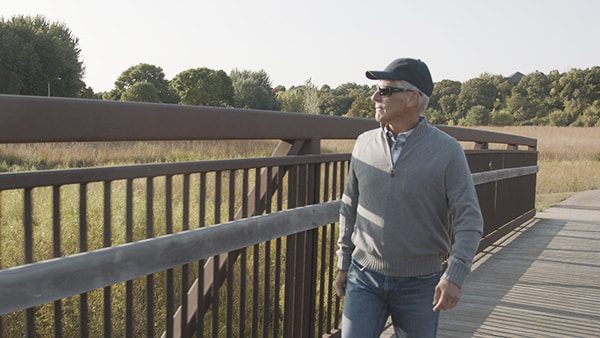Light Adjustable Lens: The Ultimate Guide
Light Adjustable Lens San Antonio Doctor’s Perspective
Once Active Shield came out on the Light Adjust during my ocular disease and refractive surgery residency at Parkhurst Nuvision, I became certified in the use of the Light Delivery Device (LDD) for the RxSight Light Adjustable Lens (LAL). This certification allows me to properly use the device to adjust the power of the LAL after cataract surgery for patients. By electively exposing the lens to UV light, I perform the light treatments and lock-in procedures with this device in office.
If I were to describe what this lens is and how it works, I would say that it is an introacular lens made out of photosensitive material that can be customized with UV light after cataract surgery. In more detail, the lens is made up of tiny particles called macromeres, which when exposed to UV light, link together and change shape. This change in lens shape is what changes the prescription of the lens and how the patient sees. When I have treated the lens to a point where the patient is satisfied with their vision (usually between 1-3 separate light treatments), I can then perform a lock-in procedure which will essentially “use-up” all of the remaining macromeres that have not linked up with their neighbor. This lock-in procedure will not change the patient’s vision as it is not inducing any specific prescription change into the lens.
When determining the best time for the first LAL light treatment, it is important to wait until the eye has fully healed after laser cataract surgery. This is because the eye’s prescription can change when there is inflammation and swelling in the eye. In my experience, the average time after cataract surgery when the eye is healed and ready for the first treatment is about 4-5 weeks, which often coincides with the time that patients can stop using their postoperative medication eye drops.
At this appointment, one of our Navigators will bring you to an exam room and check your vision in each eye at distance, intermediate and near. Many patients with the LALs have presented to this appointment with good vision already at one or two different distances after surgery, which is an excellent starting place before the first light treatment. I will examine the eyes and make sure they look nice and healthy. If they do, I will perform a refraction to determine your current prescription.

Figuring out the patient’s visual desires and how they want to best use their eyes is extremely important to me. With the opportunity to customize this IOL to visual needs, we can truly create the best vision for each individual patient’s lifestyle. I like to tell my patients that we’re in this together – I may be doing the light treatments, but it’s their vision so they must be open and honest with me about where and what they want to see.
Many patients with the light adjustable lens will tell me that they want to see clearly at distance and are OK with wearing reading glasses for near vision tasks, because that is what they are used to. Some patients prefer to be corrected for near because they are constantly on their computer or spend a lot of time reading. Then there are some patients who want to try to get as much clear vision as possible at distance, intermediate and up close. For these patients I recommend what is called monovision, which is when one eye sees better at distance and the other sees better at near and together with both eyes open the patient has functional vision at all distances.
Once the patient and I have decided how they want to use their eyes I begin the dilation process. It is very important that the eyes are dilated fully for the UV light to interact with the entire IOL during the light treatment and lock-in procedures. It is not uncommon for the patient to need two or three rounds of dilation eye drops over 1-3 hours. This length of time depends on how well the patient dilates, and unfortunately cannot be controlled by me! Various medications often taken by patients can limit how well or how quickly a patient dilates.
After the patient is fully dilated, they are moved to the room that holds the Light Delivery Device. This device looks very similar to the machine used in each exam room to examine the eyes, but the LDD has a computer monitor attached to it. Once in the room, my Navigator with prep the patient by placing an eye patch over the eye not being treated. They will then place a drop of numbing medication into the eye that is being treated to help make the patient comfortable during the treatment. The Navigator will then enter the patient’s information into the computer and confirm the patient’s refraction and preferred visual target.
I tell my patients that they have the easy job – all they must do is sit with their chin on the chinrest and forehead against the forehead rest and look directly at a small green light. I will do the rest! First, I place a contact lens onto the eye that has two roles: to make the patient comfortable and not feel like they must blink, and to help focus the UV light onto the lens itself. Then, I align the patient’s head with the machine so that both of us are comfortable in our seats. When the patient is aligned, I press my foot down onto a foot pedal to start the treatment. Each light treatment ranges from 30 seconds to 150 seconds, depending on each patient’s prescription and desired lens power. Throughout the treatment, the patient is staring at a green fixation light and while I make tiny adjustments using a joystick to keep the UV light aligned on the patient’s lens. Fortunately, I am very good at multitasking, as each hand and one of my feet all play a very important role simultaneously!
I encourage the patient to stay nice and still, as any large movements can stop the treatment. If the patient is moving too much, I may have to end the treatment and start again on a different day! I often get asked how bright the UV light is and I say that the machine in the exam room to evaluate the eyes while dilated is significantly brighter than the light used during the light treatments. I am also often asked if I’m using a laser light, and the answer is no! The LDD uses a specific wavelength of visible light (365nm, to be exact) that does not harm the UV sensitive parts of the eye. It may seem like a lot of light all at one time, but it has been tested and is not harmful in patients with healthy eyes.
Once the light treatment is complete on the first eye, it is repeated on the second eye (if both eyes are ready for treatment that day). When the first treatment is completed on both eyes, I instruct the patient to put on their UV blocking spectacles and they are walked to the lobby for check-out and to schedule their next appointment.

There must be at least 3 days between light treatments, but I have found that we have better success when we wait at least 1-2 weeks between treatments. This gives the patient time to experience their vision during their daily life and come back to me with specific feedback on how their current vision is working for them.
Between appointments, it is very important that the patient continues to wear their UV-blocking spectacles. After the laser cataract surgery with the LAL, three different pairs of UV-blocking spectacles are given: clear without a near boost, clear with a +1.50 near boost, and a pair of sunglasses. I strongly recommend that the sunglasses are always worn when outdoors, as our biggest exposure to UV light is from the sun (and even on cloudy days!). Additionally, patients need to wear their UV blocking spectacles when they are indoors and near a window.
One or 2 weeks later, the patient comes back for an evaluation. Again, their vision is checked and the eyes are examined. Together we talk about how the vision is doing and if the patient desires any changes or adjustments. In my experience, many of my patients have been happy with their vision after only the first light treatment! If that is the case, we proceed with the first of two lock-in procedures. If there is still room for improvement, I simulate any proposed vision changes so the patient can see what each change would look like and how it would affect distance, intermediate and near vision.
If another treatment is needed, two things may happen. First, if the prescription doesn’t appear to be stable, I will have the patient return to the clinic in about a week on average so I can repeat the measurements. As there are only so many macromeres to use in the lens, I need to be confident in my measurements before performing another light treatment. If the measurements are stable, we repeat the process mentioned above through dilation. It is OK to perform a light treatment on one eye one day and not the other. Each eye is different – I like to say that the eyes are like siblings and not identical twins. One eye may need 1 treatment, the other may need 3 treatments. There is no right or wrong way during this process.
When the patient is happy with their vision, it is time for the first of two lock-in procedures. As I mentioned previously, the role of the lock-in procedure is to essentially freeze all of the unused macromeres in place so they cannot be modified by exposure to UV light in our daily lives. The reason we do two lock-in procedures is because RxSight found that before two lock-ins were required, some patients were having undesired vision changes after the lock-in. In addition to requring a second lock-in, RxSight added on their ActivShield Technology, which is a layer of extra protection built into the lens.
The lock-in procedure is performed using the LDD and the patient’s role is the exact same as during the light treatments. I explain that the lock-in is going to use brighter light than what was used during the treatments and that brightness will ramp up over the first 5 seconds. The lock-ins last anywhere between 95 seconds and 120 seconds. After the first lock-in, the patient is instructed to return in 1 week for the second and final lock-in. The UV-blocking spectacles must be worn until 24-hours after the final lock-in.
At no point during the light treatment or lock-ins should the patient be in any pain. They are non-invasive treatments. Some patients have shared with me that they have seen a temporary red or purple hue to their vision after the lock-in procedures, or have seen a temporary afterimage of the fixation target seen during the treatments. Again, these are temporary and should not be a cause for concern.
It has been incredibly exciting to experience the visual results of my patients after their final lock-in with the LDD. The customizability of the LAL is extraordinary and really does give the patient the opportunity to try-out their vision in their daily lives.

Be sure to talk to one of our doctors about not only the benefits of vision correction, but also any risks of vision correction that may pertain to your individual needs and circumstances.

